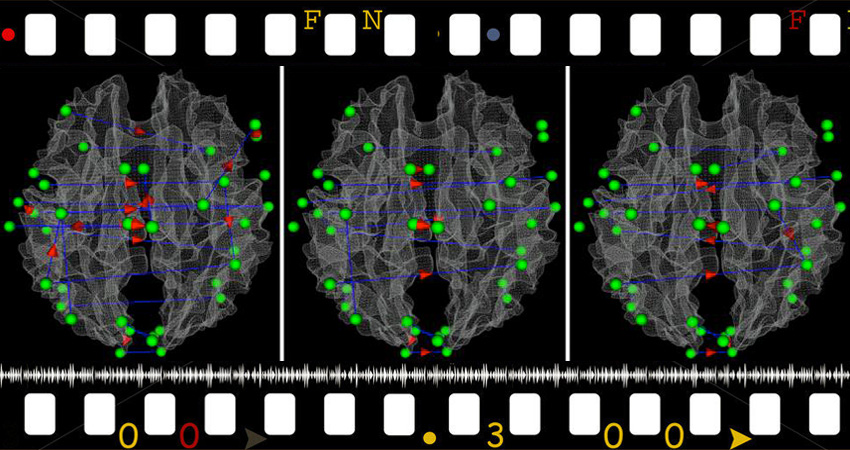Research cluster combines brain science, film studies to analyze responses to movie trailers

We return to our series of profiles on the Willson Center’s Faculty Research Clusters with this month’s spotlight on Neuroimaging, Movie Trailers, and Spectator Cognition, co-directed by Tianming Liu, L. Stephen Miller, and Richard Neupert.
The seeds for this interdisciplinary project were planted several years ago when Liu approached Neupert after the latter gave a Willson Center “Humanities for Scientists” talk about moving images and perception. Liu is an associate professor of computer science who conducts research in UGA’s Cortical Architecture Imaging and Discovery lab, while Neupert is Wheatley Professor of the Arts and film studies coordinator in the department of theatre and film studies.
One of the main themes of Liu’s work has been dubbed “neuromediomics,” an interfacing of brain imaging and multimedia studies. He has been conducting research on responses to various media such as television news programs, music, and films for some time, and has published numerous groundbreaking studies. In Neupert, he found a collaborator who, as a leading scholar of film history and theory, could bring to the research an advanced understanding of the detailed mechanisms of film and how those tools are used to communicate with audiences.
Liu then recruited Stephen Miller, a professor of psychology and expert in neuropsychology and cognition who is director of UGA’s Bio-Imaging Research Center, with which Liu is also affiliated. The trio formed a research cluster as soon as the Office of the Vice President for Research and the Willson Center announced the program.
The goal of the group’s three-year study will be to quantify viewer responses to movie trailers through detailed analysis of fMRI brain scans. The researchers decided to work with trailers because of their compact, focused, highly directed nature. Trailers are “intensified little spectacles” that tell “tiny, little stories,” Neupert said.
Miller added that trailers are constructed with “a clear attempt at the conveyance of enthusiasm and interest.” They offer an excellent opportunity to gauge “what attracts people to certain kinds of visual and auditory images, and perhaps what doesn’t so well,” he said.
About two dozen trailers will be selected from an initial pool of more than 800 based on specific criteria. First, all of the trailers will have been rated either very highly or very poorly by YouTube viewers. Then, trailers will be carefully analyzed for their form and content: the researchers are interested in samples with a variety of approaches to distinguishing features such as editing rhythm, camera movement, color saturation, and use of sound.
These characteristics will be painstakingly diagrammed for each trailer, and undergraduate students will “rate” them in greater detail than the binary “like/dislike” YouTube scale. Then, the team will begin scanning the brains of subjects while they view the trailers.
The fMRI scans will provide “a real-time measure of the activity of the brain under the actual viewing of these trailers,” Miller said. The scans track minute changes in blood flow to specific areas of the brain, which are used to infer neural activity.
Using data from the scans, the researchers will look for correlation between any patterns in brain activity that may emerge and the ratings by students and YouTube viewers. “We have made pretty good progress in the past half-year, and we are quite confident” the research will reveal some “common patterns” in brain responses to similarly ranked trailers, Liu said.
Eventually, Miller said, “we’d like to be able to predict the components of these different kinds of visual and auditory images that individuals [respond to], and their relationships to the emotions, and predict the relative enthusiasm that anyone might have for these.”
Such findings could have far-reaching impacts, the cluster directors believe. “Certainly, there are applications for advertising, applications for filmmaking, applications for web design in all of this,” Neupert said. “What grabs the brain?”
The selection of trailers is nearly complete, Liu said, and the group will begin doing “pilot scans” for the study this semester. If they can secure enough funding, he said, they would like to collect brain response data from as many as 100 subjects. Those scans will take place over the second year of the study, and the third year will be spent processing the data from the scans and preparing the study for publication.
Neupert hopes the study will provoke keen interest in several different fields. “It would be nice to have people talking about this in a psychology conference,” he said, “as well as computer science and brain scanning, and also in a film studies conference – to make it truly interdisciplinary.”
